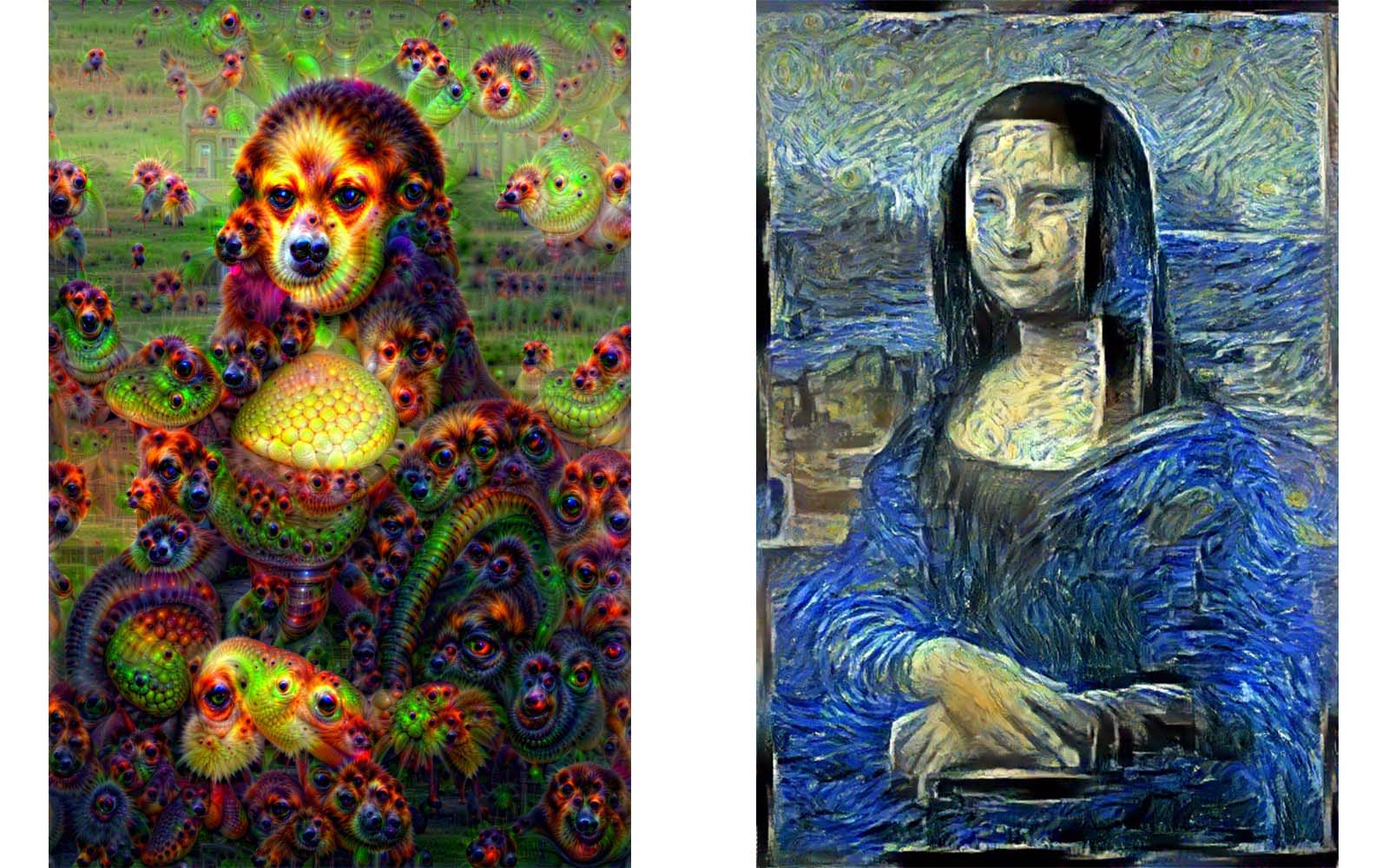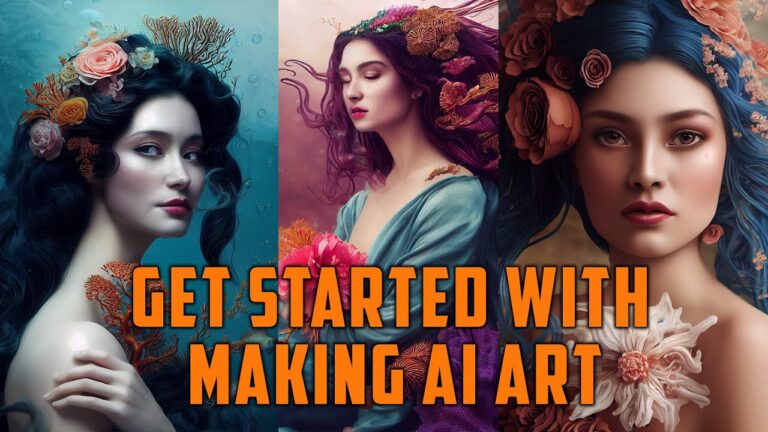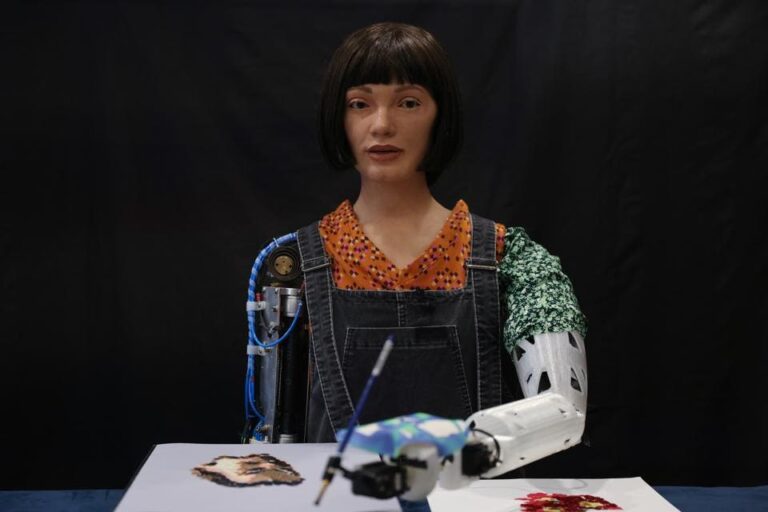AI art works by using algorithms and neural networks to generate images based on input data and learned patterns. AI art combines technology and creativity.
Artists and developers use machine learning models, such as Generative Adversarial Networks (GANs), to produce unique artwork. These models learn from vast datasets of images and mimic styles, textures, and patterns. The process involves training the AI with numerous examples, allowing it to understand various artistic techniques.
Users can then input parameters or feed new images to guide the AI in creating new art pieces. AI art democratizes creativity, enabling anyone with access to these tools to produce visually stunning works. This innovation is revolutionizing the art world, blending human imagination with machine precision.

The Emergence Of Ai In Art
Art has always been a reflection of human creativity. Today, technology is changing the way we create art. Artificial Intelligence (AI) is at the forefront of this transformation. AI can now produce stunning pieces of art, rivaling human artists. This section explores how AI is reshaping the art world.
From Brushes To Algorithms
Artists once used brushes, paint, and canvas to create masterpieces. Now, they use algorithms and data. AI algorithms analyze patterns and styles in existing artworks. They then use this data to create new, unique pieces. The result is art that blends human creativity and machine precision.
AI art is not just about replicating human styles. It also opens new possibilities. Artists can now experiment with forms and techniques. AI helps them push the boundaries of traditional art.
The Evolution Of Creative Machines
AI art has come a long way. Early AI programs could only generate simple patterns. Today’s AI models are far more advanced. They can mimic famous artists, create original styles, and even learn from their own creations.
| Era | AI Capabilities |
|---|---|
| Early AI | Simple patterns and shapes |
| Modern AI | Complex, original artworks |
AI art tools are also more accessible now. Artists of all skill levels can use them. This democratizes the art world, making it more inclusive.
- AI art mimics human creativity.
- It learns and evolves.
- AI tools are accessible to everyone.
- Early AI created simple art.
- Modern AI creates complex, unique pieces.
The evolution of creative machines is ongoing. Each advancement brings new possibilities. AI continues to redefine what is possible in the world of art.
Demystifying Ai Art Generators
AI art generators can create amazing art. But how do they work? Let’s break down the process to understand it better. This blog post will explain the mechanics and key technologies behind AI art.
The Mechanics Behind The Scenes
AI art generators use complex algorithms to create art. These algorithms learn from existing art. They study patterns, colors, and styles. Then, they create new art based on what they learn.
These algorithms need a lot of data. They are fed thousands of images. This helps them learn different styles and techniques. The more data they have, the better they become at creating art.
AI also uses neural networks. Neural networks work like our brains. They process information and make decisions. In AI art, they decide what colors to use, what shapes to draw, and more.
Key Technologies Powering Ai Art
| Technology | Description |
|---|---|
| Machine Learning | Helps AI learn from images and improve over time. |
| Neural Networks | Works like a brain to make decisions in art creation. |
| Deep Learning | Uses layers of algorithms to process complex data. |
| Generative Adversarial Networks (GANs) | Two networks work together to create more realistic art. |
Machine Learning is crucial. It helps the AI learn from images and improve over time. Neural Networks mimic the human brain. They help the AI make decisions in art creation.
Deep Learning adds complexity. It uses layers of algorithms to process data. Generative Adversarial Networks (GANs) are very advanced. They use two networks to create realistic art. One network creates, and the other criticizes. This makes the art better and better.
These technologies work together to create beautiful AI art. They make the process faster and more accurate. AI art generators are a blend of art and technology.
Neural Networks And Deep Learning
Understanding how AI creates art involves exploring neural networks and deep learning. These technologies mimic human brain functions to generate unique artworks.
Understanding Neural Networks
Neural networks are a set of algorithms. These algorithms are designed to recognize patterns. They consist of layers of nodes. Each node simulates a neuron in the human brain. Nodes are connected by links, which transmit information.
Neural networks process data through these connections. They adjust based on the information received. This learning process allows them to improve over time. They can learn to identify shapes, colors, and even complex artistic styles.
| Component | Function |
|---|---|
| Nodes | Simulate neurons, process data |
| Links | Transmit information between nodes |
| Layers | Different stages of data processing |
Deep Learning’s Role In Artistic Creation
Deep learning builds on neural networks. It uses multiple layers to analyze data deeply. This technology excels in creating detailed art. It can understand and replicate complex patterns.
Deep learning involves training the network. This training uses vast amounts of data. The network learns to generate new artworks. These artworks mimic the styles of the training data.
- Input Data: Images and artworks are provided.
- Training: The network learns from this data.
- Generation: The network creates new artworks.
Deep learning can create a variety of art. It can produce paintings, drawings, and even digital sculptures. The results are often surprising and innovative.
The combination of neural networks and deep learning has revolutionized AI art. These technologies enable machines to create art that is both unique and expressive.

Generative Adversarial Networks (gans)
Generative Adversarial Networks, or GANs, have revolutionized AI art. They consist of two neural networks, a generator, and a discriminator. These networks work together in a unique way to create stunning art.
The Battle Of Algorithms
The generator and the discriminator are like rivals. The generator creates new images, trying to fool the discriminator. The discriminator evaluates these images and determines if they are real or fake. This process helps both networks improve.
This rivalry pushes the generator to produce more realistic images. The discriminator also gets better at spotting fake images. This continuous battle results in highly detailed and realistic art.
How Gans Shape Artistic Outputs
GANs have the power to transform simple sketches into detailed artwork. They can also generate entirely new images from scratch. These networks learn from vast datasets of existing art, understanding patterns and styles.
Using this knowledge, GANs can create art that mimics famous artists. They can also develop unique, original pieces. This capability opens up exciting possibilities in the world of digital art.
| Aspect | Description |
|---|---|
| Generator | Creates new images |
| Discriminator | Evaluates images |
| Learning Process | Continuous improvement |
The combination of a generator and a discriminator leads to impressive results. GANs are paving the way for new forms of artistic expression.
Training Ai For Artistic Expression
Training AI for artistic expression is a fascinating process. Machines learn to create art by analyzing data. This involves teaching AI to understand and mimic human creativity. The process is complex and requires vast amounts of data and sophisticated algorithms.
Data Sets And Learning Processes
AI needs large datasets to learn from. These datasets include thousands of images, paintings, and sketches. The AI studies these images to understand styles, patterns, and techniques.
Here are some key components of the learning process:
- Data Collection: Gathering diverse artworks.
- Preprocessing: Cleaning and organizing data.
- Training: Feeding data to the AI model.
- Validation: Checking AI’s output against real art.
During training, the AI uses neural networks. These networks mimic the human brain. They help the AI recognize intricate details in the artworks.
Challenges In Training Ai Artists
Training AI artists comes with challenges. One major challenge is the subjective nature of art. What one person sees as beautiful, another may not.
Other challenges include:
- Data Quality: High-quality data is essential.
- Bias: AI can inherit biases from its training data.
- Computational Power: Requires significant resources.
- Creativity: Balancing originality with learned styles.
Addressing these challenges requires careful planning. It also requires ongoing adjustments to the AI model.
Training AI for artistic expression is an evolving field. With advancements, AI can achieve remarkable creativity.
The Human-ai Collaboration In Art
The collaboration between humans and AI in art is fascinating. It combines human creativity with AI’s computational power. This partnership creates unique and innovative artworks. Understanding this collaboration helps appreciate the evolving art landscape.
Artists’ Roles In An Ai-driven Process
Artists play a crucial role in the AI-driven art process. They define the creative vision and set the parameters for AI. They select the style, colors, and themes.
Artists also provide the initial input, such as sketches or concepts. They guide the AI, ensuring the final artwork aligns with their vision. This input is vital for achieving a harmonious blend of human and AI creativity.
Collaborative Works And Their Impact
Collaborative works between humans and AI have a significant impact. They push the boundaries of traditional art. These works often feature a mix of human emotion and AI precision.
Such collaborations also open new possibilities for art exploration. They inspire new techniques and styles. This fusion creates art that is both innovative and engaging.
Below is a table showcasing some notable collaborative works and their impact:
| Artwork | Impact |
|---|---|
| The Next Rembrandt | Blends classic art with modern AI |
| Portrait of Edmond de Belamy | First AI artwork sold at auction |
| AI-Generated Music | Explores new musical landscapes |
These examples highlight the transformative power of human-AI collaboration. They show how AI can enhance and expand artistic expression.
Ethical Considerations And Authorship
AI art raises many questions about ethics and authorship. It challenges traditional views of creativity. We need to explore these issues to understand AI art better.
Debating Originality And Creativity
Is AI-generated art truly original? This question sparks debate. AI algorithms often learn from vast datasets of human-made art. They analyze patterns and styles. Then, they create new pieces based on this learning. But, can this process be called original? Some argue that AI simply mimics human creativity. Others believe it offers a new form of innovation.
Consider the role of the AI programmer. They design and train the AI. Is the programmer the true artist? Or is the AI itself the creator? This debate challenges our understanding of creativity and originality.
Copyright Issues In The Ai Art World
Copyright laws are complex. They are even more so for AI art. Traditional laws protect human creators. But, how do they apply to AI-generated works? Can an AI hold a copyright? Or does it belong to the programmer?
Here are some key points:
- Ownership: Who owns the rights to AI-generated art? The programmer, the AI, or the user?
- Infringement: AI may unintentionally copy existing works. This raises concerns about plagiarism.
- Licensing: How should AI art be licensed? New frameworks may be needed.
A table to summarize these points:
| Issue | Consideration |
|---|---|
| Ownership | Who holds the copyright? |
| Infringement | Risk of unintentional copying |
| Licensing | Need for new frameworks |
These issues need careful thought. They will shape the future of AI art.
The Future Of Ai-generated Art
The future of AI-generated art is bright and exciting. With rapid advancements, AI can create stunning pieces. These artworks often rival human creativity. The blend of technology and art is reshaping the industry. Let’s explore emerging trends and potential impacts.
Emerging Trends And Predictions
AI art is evolving at a fast pace. Here are some key trends:
- Personalized Art: AI can create custom artworks based on user preferences.
- Collaborative Creations: Artists and AI working together to produce unique pieces.
- Interactive Art: Viewers can interact and influence the artwork in real-time.
Predictions for the future include:
- AI tools will become more accessible to everyone.
- More artists will use AI to enhance their work.
- AI art will be featured in major galleries and museums.
The Potential Impact On The Art Industry
AI-generated art is changing the art industry. Here are some potential impacts:
| Impact | Description |
|---|---|
| New Revenue Streams | AI art can be sold as unique digital pieces. |
| Enhanced Creativity | Artists can use AI to explore new styles and techniques. |
| Global Reach | AI art can easily be shared and sold worldwide. |
Artists can now explore new styles and techniques. AI art can easily be shared and sold worldwide. The fusion of AI and art is creating endless possibilities.
Public Perception And Reception
AI art is gaining attention. People have mixed feelings about it. Some are excited, while others are skeptical. Let’s dive into how different groups react to AI art.
The Art Community’s Response
The art community has diverse opinions. Some artists see AI as a tool for creativity. They believe it can enhance their work. Others feel AI lacks the human touch. They worry it may devalue traditional art.
Here are some views from the art community:
- Enthusiasts: Embrace AI for its innovative potential.
- Skeptics: Fear it might replace human artists.
- Neutral: View it as just another art form.
Acceptance Of Ai Art By The Masses
The general public is also split. Some enjoy the novelty of AI art. They find it fascinating and unique. Others miss the human element in art. They feel AI art is impersonal and cold.
Here is a simple table showing public opinion:
| Group | Opinion |
|---|---|
| Tech Enthusiasts | Love the innovation. |
| Traditional Art Lovers | Prefer human-made art. |
| Casual Viewers | Mixed feelings. |
Understanding these perceptions helps us appreciate the evolving world of AI art. It shows how technology influences our view of creativity.
Ai Art In The Marketplace
AI art is now a hot trend in the marketplace. This new form of art is changing how we see creativity. With AI technology, artists and buyers are finding new opportunities. Let’s explore how AI art is making waves in the market.
Monetizing Machine-made Masterpieces
AI art is creating new ways to make money. Artists use AI tools to create unique pieces. These digital artworks can be sold online or in galleries. Some artists sell their AI art as non-fungible tokens (NFTs). NFTs are special digital items that can’t be copied. They give buyers proof of ownership. This makes AI art valuable and collectible.
Here are some ways artists are monetizing AI art:
- Online Marketplaces: Websites where artists sell AI art directly to buyers.
- Prints and Merchandise: Turning AI art into posters, t-shirts, and other items.
- Commissions: Creating custom AI art for clients.
The Rise Of Ai Art In Galleries And Auctions
AI art is also gaining popularity in galleries and auctions. Traditional art spaces are now showcasing AI-generated works. This brings more visibility to AI art and attracts collectors. Some AI artworks have sold for high prices at auctions. This proves that AI art is becoming a serious part of the art world.
Here are some examples of AI art in galleries and auctions:
| Event | Location | Notable Sale |
|---|---|---|
| Christie’s Auction | New York | “Edmond de Belamy” sold for $432,500 |
| Sotheby’s Auction | London | “Memories of Passersby I” sold for $51,000 |
This trend is opening new doors for AI artists. It allows them to reach a wider audience and gain recognition. As more people accept AI art, its value in the marketplace will likely grow.

Frequently Asked Questions
Where Does Ai Art Get Its Images?
AI art gets its images from vast datasets of existing artwork. These datasets are compiled from public domain images, licensed sources, and user submissions. AI algorithms analyze these images to create new, unique art pieces. This process ensures diverse and creative outputs.
How Does Ai Art Create Art?
AI art creates art by using algorithms and neural networks. It analyzes existing artworks and generates new pieces. AI models learn patterns and styles from vast datasets. This allows them to create unique and diverse art forms.
How Are Ai Images Generated?
AI images are generated using algorithms and neural networks. These models analyze and learn from large datasets. They create new images based on patterns and features identified in the data. Popular techniques include Generative Adversarial Networks (GANs) and Variational Autoencoders (VAEs).
Do You Own The Ai Art You Create?
Yes, you own the AI art you create. Rights typically belong to the creator, but check the tool’s terms.
Conclusion
AI art is revolutionizing creativity with its blend of technology and imagination. It offers endless possibilities for artists and designers. As AI continues to evolve, its impact on art will grow, pushing creative boundaries. Embrace this innovative tool to enhance your artistic journey and explore new horizons.





